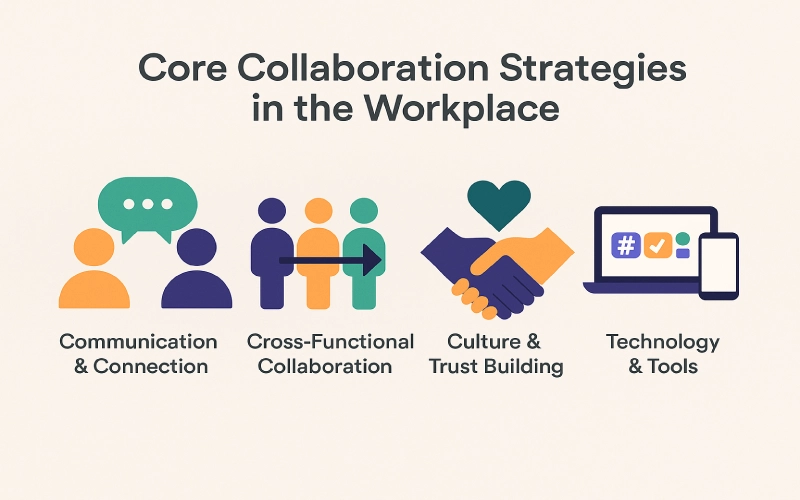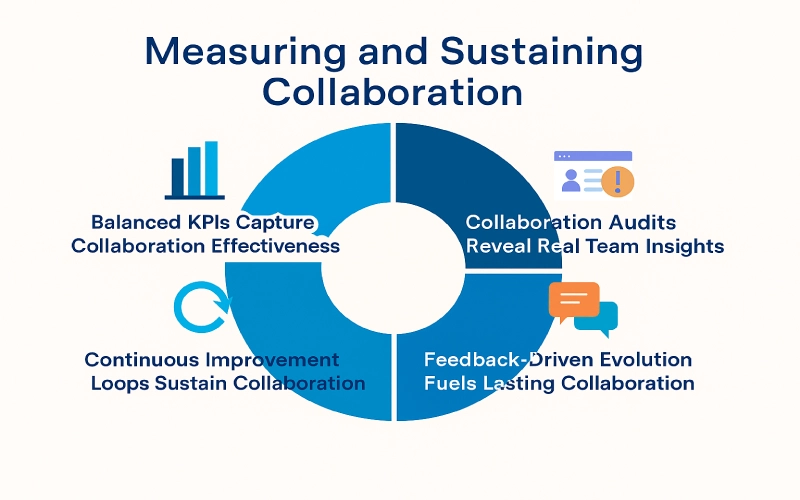In today’s work landscape, most Fortune 100 companies support remote or hybrid models that rely on effective teamwork.
Collaboration is the primary factor in driving workers to perform better, making them 8 times more likely to put in extra effort. For business decision-makers, learning the partnership skill is no longer a choice, but a necessity for survival.
Collaboration in the workplace occurs when individuals come together for a common purpose, whether face-to-face or virtually. Digital collaborative tools have taken on a new role to fill the gap left by conference rooms.
This new arrangement makes it mandatory for the people involved to devise new strategies that ensure continued team interaction and productivity.
Working together makes people more productive, involved, and creative in mixed work environments.
Teams that work well together can be up to 25% more productive than teams that don’t (McKinsey & Company, 2023). To succeed in this complex world, your culture must value collaboration and teamwork.

Contents
- 1
- 2 Defining Collaboration in the Workplace
- 3 The Importance of Workplace Collaboration
- 4 Key Elements of a Collaborative Workplace
- 5 Common Barriers to Collaboration
- 6 Core Collaboration Strategies in the Workplace
- 7 Advanced Insights: Modern Collaboration Dynamics
- 8 Measuring and Sustaining Collaboration
- 9 Leadership’s Role in Fostering Collaboration
- 10 The Future of Collaboration in the Workplace
- 11 Final Thoughts: Collaboration Grows from Trust and Clarity
Defining Collaboration in the Workplace
What Collaboration Really Means
To define collaboration in the workplace, we need forward-looking leaders who facilitate people coming together to reach shared goals.
It’s about blending skills, ideas, and efforts to create better outcomes. Unlike simple cooperation, it demands active engagement and collective creativity.
Collaboration vs. Cooperation and Teamwork
Cooperation is defined as the act of assisting with various tasks, while teamwork involves contributing one’s efforts towards a shared objective.
Collaboration, however, takes it one step further by fostering creativity, sustainability, and diversity of views, thereby resolving the issue of resistance to change.
The Shift to Digital Collaboration
In the past, collaboration often occurred through face-to-face interactions in conference rooms.
Nowadays, digital tools provide services that connect hybrid and remote teams through video calls or messaging apps. This shift enables leaders to facilitate continuous and flexible collaboration.
Collaboration in Practice: Cross-Department Hybrid Teams
Imagine a team from marketing, product, and engineering in the process of launching a new project.
All teams are using the same tools, discussing the issues during meetings, and working towards a common objective. Not only does it resolve problems at a fast pace, but it also generates new ideas simultaneously.
The Importance of Workplace Collaboration
Collaboration is key to driving results in modern organizations. It speeds up problem-solving, strengthens team bonds, and helps companies adapt faster. When teams work together effectively, they unlock greater innovation, engagement, and efficiency.
Collaboration Boosts Efficiency
Collaboration means breaking down silos and working together to solve problems faster.
A Collaboration enables teams to solve problems that would be challenging for individuals to tackle. It helps avoid redundancy and aligns with others working on similar goals.
Collaboration Enhances Employee Engagement
Cooperation is a feature that makes employees feel that their importance within the company grows.
Some studies show that teamwork with a high team spirit remains united through a shared purpose. Healthy collaboration fosters trust and meaning, which are key to team member retention.
Collaboration Fuels Adaptability
Organizational adaptability depends on collaboration that allows a quick response to change and new information. Flexible teamwork enables companies to pivot smoothly and capitalize on emerging opportunities.
Business Impact of Collaboration
According to research data, the best workers are 5.5 times more likely to encourage teamwork. This partnership yields clear benefits, including faster decision-making and improved output.
Key Elements of a Collaborative Workplace
Effective workplace collaboration is built on foundational elements such as trust, shared goals, open communication, diversity, appropriate technology, and strong leadership. These components collectively create an environment where teams can work cohesively, think creatively, and drive meaningful results.

Trust Enables Collaboration
When the team trusts one another and feels safe, people can be honest and creative in solving problems, without fear of judgment. Working together is just like second nature when people have that peace of mind and feeling of security.
When everyone on a team shares the same goals, it provides them with a clear path to follow.
This alignment makes things less likely to go wrong and helps people focus. When people know what they want to achieve, they can work together to accomplish it.
Open Communication Builds Clarity
Good communication among team members prevents confusion, while smooth communication keeps the team cohesive and united.
Making things clear means that we will be able to work as a team, supporting one another to make informed decisions.
Diversity Enhances Creativity
Diversity brings different perspectives that enhance creative problem-solving and generate new ideas.
Teams that are open to everyone challenge each other and improve ideas more effectively. Different perspectives lead to more innovative solutions.
Technology Enables Collaboration
Technology must not only cater to, but also foster, team productivity. Team success largely depends on the correct use of the right tools.
Technology, when employed appropriately, is the first step in cultivating a united team and simultaneously eliminating distractions.
Leadership Drives Collaboration
Leadership must actively support collaboration by modeling cooperative behaviors and rewarding teamwork. Leaders set the tone, encouraging open exchange and shared success. Their backing makes collaboration a strategic priority.
Common Barriers to Collaboration
Silos Stall Collaboration
Silos and hierarchies within organizations make it more challenging to be open and make informed decisions.
70% of customer service professionals believe that the silo mentality is the biggest problem in customer service. To solve problems more quickly, leaders should eliminate silos.
Poor Communication Creates Confusion
Unclear communication and poor accountability measures are a recipe for projects to get lost in the cracks. When no one is held accountable for specific updates or results, confusion can arise quickly.
Misaligned Goals Undermine Teamwork
When teams have different priorities, it causes tension and slows down progress. When groups have different goals, they tend to work together less effectively. Setting goals early on helps avoid unnecessary conflicts.
Too Many Tools Hinder Work
Having a fragmented technology that lacks consistency contributes to more problems. Teams that use five communication tools simultaneously often repeat work and waste time. Eliminating a few platforms will be a significant boost to productivity.
Remote Work Tests Connection
Remote work poses unique challenges, such as mismatched time zones and hidden efforts. Lack of visibility leads to misunderstandings and disengagement. Intentional communication methods bridge distance and build trust.
Over-Collaboration Causes Fatigue
Collaboration overload can drain employees, forcing them to attend numerous meetings. Constant interruptions inhibit the flow of creative juices. Intelligent scheduling minimizes unnecessary meetings and preserves the benefits of collaboration.
Core Collaboration Strategies in the Workplace
Unlock team potential through purposeful collaboration. From structured communication and cross-functional teamwork to trust-building and smart tech adoption—these pillars create a workplace culture where productivity and innovation thrive.

Communication & Connection: Start with structured communication Rituals, such as daily standups and retrospectives, to keep teams aligned. Leverage shared dashboards for better visibility and monitoring of results. In virtual teams, asynchronous reports ensure that no one is left behind, keeping the workflow on track.
Cross-Functional Collaboration: Projects that require innovation and are about moving things forward should receive support. People become more creative and productive when they collaborate beyond their departments. Encourage employees from various departments to collaborate on a project.
Culture & Trust Building: Recognize and incentivize teamwork as a means to foster positive collaborative routines throughout the organization. Guide leaders in showing empathy by listening attentively and providing feedback that creates trust. Create environments where team members feel comfortable sharing their thoughts and ideas.
Technology & Tools: Adopt platforms like Slack, Asana, or Notion that streamline your team’s workflow and encourage regular usage. Limit the tools that bring value; too many will overwhelm employees.
Advanced Insights: Modern Collaboration Dynamics
Collaboration Overload
High amounts of meetings and messaging done regularly have downsides; the chief of them is lessened productivity. Hence, one possible solution is to limit the number of conferences and opt for asynchronous updates for teamwork communication.
Data-Driven Collaboration Measurement
Analytics are excellent for measuring the effectiveness of a team. The success of a project, the cross-functional departmental involvement, and the metrics of team member feedback show the progress of cooperation among teams. The data will indicate which of the collaboration and productivity settings is the best.
Cultural & Generational Factors
Each culture and age group has its own unique way of communication, resulting in distinct experiences of collaboration and interaction. A leader will view it as an asset and bridge the gap among team members. Intermingling people sustains more sophisticated, vibrant, and positive relationships.
Engineering Collaboration
“Collaboration by design” implies pre-planning the working process, assigning tasks to individuals, and determining the form of rewards to strengthen teamwork. Organizational processes and incentives foster mutuality and facilitate the attainment of organizational goals.
Measuring and Sustaining Collaboration
To truly sustain effective collaboration, organizations must track what matters. From using KPIs and feedback to auditing team dynamics and refining processes, each step helps uncover insights, improve synergy, and maintain long-term team performance.

Balanced KPIs Capture Collaboration Effectiveness
You can utilize very specific KPIs, such as the rate of project completion, the frequency of communication, and the team member feedback score. This way, you can strengthen the team and provide the organization with a complete picture of what is going smoothly.
Collaboration Audits Reveal Real Team Insights
Collaboration audits are particularly significant in identifying problems that the team might otherwise overlook. Honest feedback is a turning point for employees to improve and make better choices.
Continuous Improvement Loops Sustain Collaboration
To build a loop of continuous improvement, assess and improve collaboration, and strategize repeatedly. Minor, consistent tweaks keep collaboration fresh and compelling.
Feedback-Driven Evolution Fuels Lasting Collaboration
Some businesses adjust their working methods based on immediate feedback, resulting in significant improvements in productivity and culture.. One way to welcome differences and create opportunities for change is by sharing your positive achievements with them.
Leadership’s Role in Fostering Collaboration
Leadership Behaviors Spark Collaboration
Leaders empower employees to share their ideas and take ownership of their work. These actions help people be enthusiastic about working together. They model transparency and encourage cross-team interactions.
Leadership Development Enables Collaboration Success
Enhancing leadership training, coaching, and mentoring improves the skills that lead to effective collaboration. Such programs foster empathy, conflict resolution, and inclusive leadership styles. Well-prepared leaders result in stronger, more connected teams.
The Future of Collaboration in the Workplace

Empowering Teams with Intelligent Automation
AI collaboration tools enhance business by automating tedious tasks and fostering creativity. These tools support workers in their engagement with essential tasks, helping them become more versatile.
Creating Connected Hybrid Work Environments
The hybrid environment is all about embracing work style flexibility and fostering team collaboration. Tool integration uplifts people and bridges the culture of inclusivity and mutual respect.
Harmonizing Human Intelligence and Automation for Success
Machines are fast and accurate, while people are creative and understanding. Leaders must be flexible, observant, and cultivate cultures that embrace technology as a valued partner.
Final Thoughts: Collaboration Grows from Trust and Clarity
Frequent and open communication among employees fosters a sense of unity, understanding, and enthusiasm. The moment people’s emotions are acknowledged, they express themselves more openly and authentically.
Managers will have to set a good example for the rest by being open, just, and respectful of every person. Giving credit where it is due motivates people to take responsibility for their work, and it unifies them. When managers use incentives to foster unity rather than competition, the result is teamwork.
Pause now and bring the team together to align its vision with othership. Create an atmosphere where the team is relaxed and free to speak during the informal get-togethers. Post and share this message with your team to demonstrate your concern and commitment to a cultural revolution.




You must be logged in to post a comment.